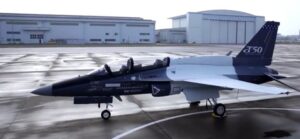
Boeing-SAAB T-X entry
It may be an exaggeration to say the companies are dropping out of the T-X competition like flies, but the Northrop Grumman-BAE Systems team‘s decision to drop out today means that at least four of the biggest defense companies in the world decided they couldn’t come up with competitive offerings for the Air Force’s next generation trainer.
“Northrop Grumman and its principal teammate BAE Systems have carefully examined the U.S. Air Force’s T-X Trainer requirements and acquisition strategy as stated in the final request for proposals issued on Dec. 30, 2016. The companies have decided not to submit a proposal for the T-X Trainer program, as it would not be in the best interest of the companies and their shareholders,” today’s statement says.
The Raytheon-Leonardo team dropped out on Jan. 25, leaving us with these competitors: Lockheed Martin-KAI, Boeing-Saab, and Sierra Nevada-TAI. This doesn’t raise questions about the Air Force’s approach — yet. It does raise intriguing questions about the costs of providing a system that can mimic enough aspects of a fifth-generation aircraft to train pilots at a reasonable price. A contract award is expected in the second half of this year. Lockheed is offering an existing aircraft, Boeing created a new one from scratch, and Sierra Nevada is building a new one with the Turks.

Lockheed T-X plane
Byron Callan, a defense stock analyst, said in a note that the drop-outs leave Boeing as the front-runner. Boeing and SAAB have done an impressive job of designing, building and flying a new aircraft, with the first flight taking plane on Dec. 21. Byron notes that the Boeing plane includes twin stabilizers, as do the war planes the pilots will be training to fly. Sierra’s aircraft does too but it hasn’t flown yet. Lockheed’s plane is a modified T-50.
As Breaking D readers know, Lockheed Martin says a new design will cost $1 billion more than a plane already in production. They’ve been pressing the Air Force to amend its evaluation to give an existing design credit for those “savings.” Hasn’t happened yet.
Navy jet trainer fleet operations remain paused after engine mishap
One week after the incident, a Navy spokesperson says the service is continuing to assess the fleet’s ability to safely resume flight.


























